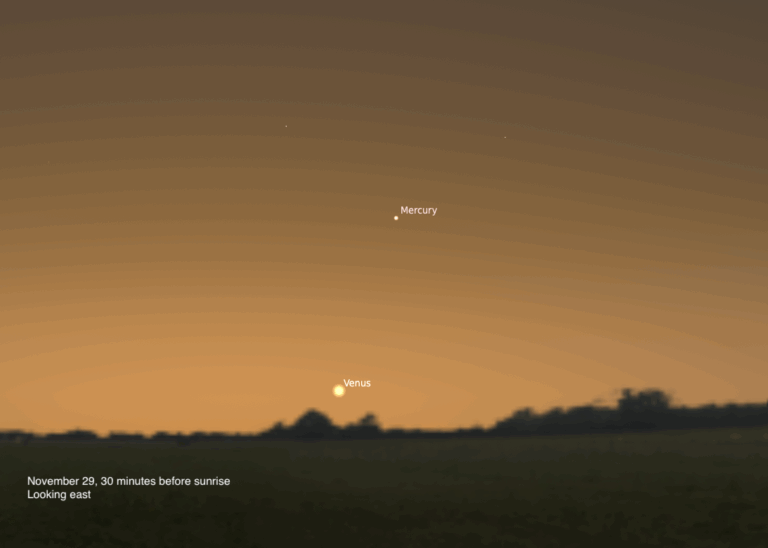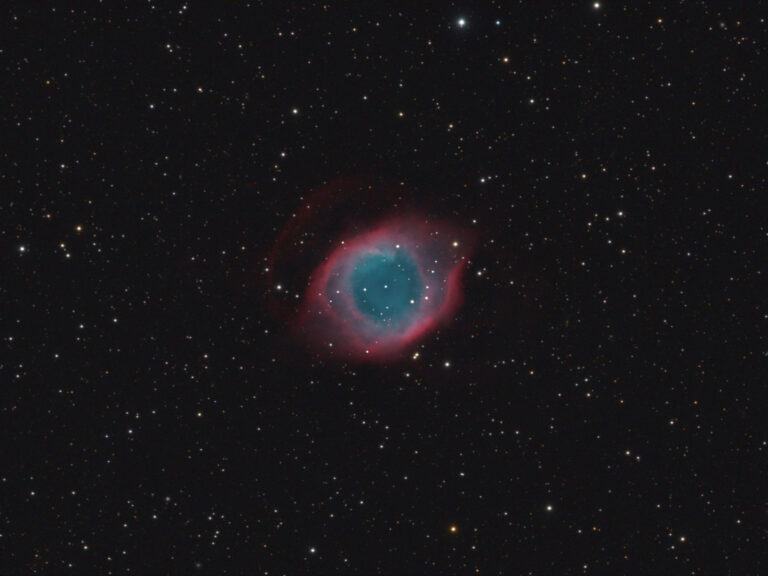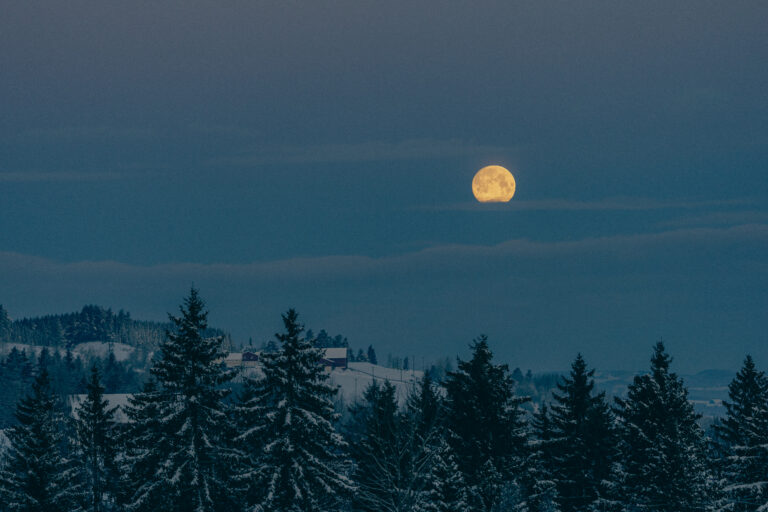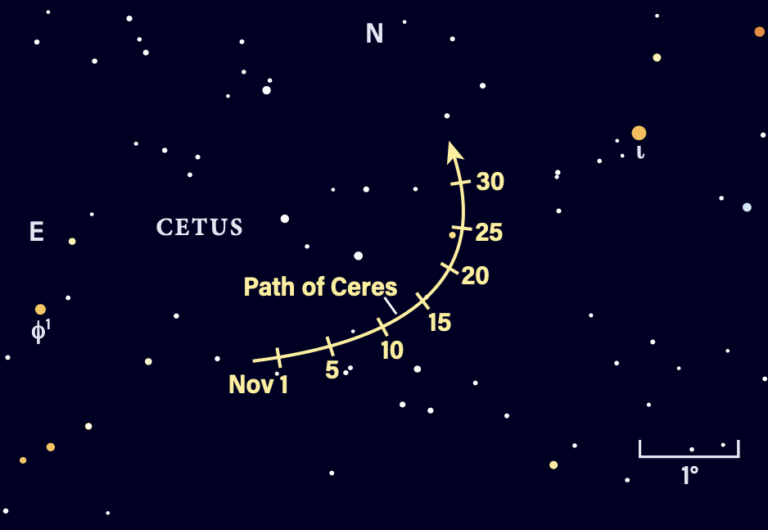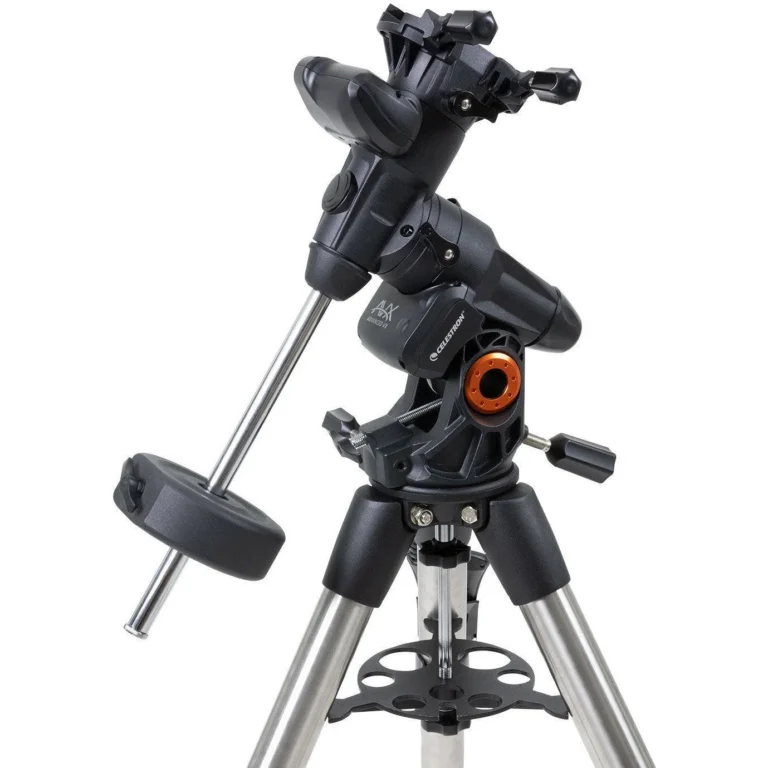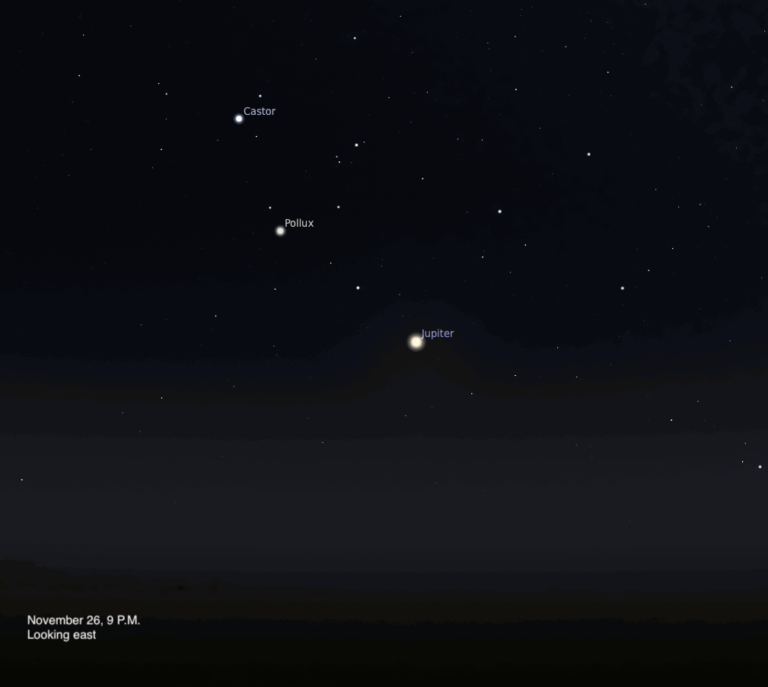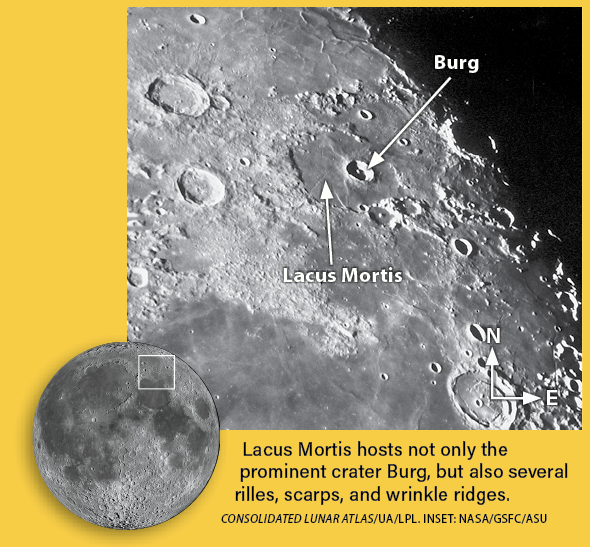Key Takeaways:
Friday, February 17
Look west just after sunset to catch Venus and Jupiter hanging above the horizon. Venus is lower and brighter (magnitude –3.9), while magnitude –2.1 Jupiter stands to the upper left of the blazing evening star.
Zoom in on Jupiter with a telescope around 6:50 P.M. EST to see the small moon Io already transiting the disk. Within 10 minutes, Io’s shadow has joined it, slipping over the cloud tops from the east. (The event is already underway as twilight falls in the Midwest.) The pair will travel across the planet’s face together until Io clears the western limb just before 8:20 P.M. EST. Its shadow will continue its trek, the dark blot finally disappearing about an hour later, after the planet has set on the East Coast.
The other three Galilean moons are also on display: Europa to the west, and Ganymede (closer in) and Callisto to the east. There’s even an extra bonus: Jupiter’s Great Red Spot is also transiting the disk this evening, appearing roughly in the middle of the planet’s visible face around 7:20 P.M. EST. See if you can spot the giant storm as a darker, orange-red blotch in the planet’s southern hemisphere.
Sunrise: 6:50 A.M.
Sunset: 5:38 P.M.
Moonrise: 5:16 A.M.
Moonset: 2:20 P.M.
Moon Phase: Waning crescent (10%)
*Times for sunrise, sunset, moonrise, and moonset are given in local time from 40° N 90° W. The Moon’s illumination is given at 12 P.M. local time from the same location.
Saturday, February 18
Mercury is quickly growing harder to catch in the predawn sky, dropping lower each morning even as its brightness slightly increases with increasing proximity to the Sun. This morning may be your last chance to catch it for a while, as the planet heads for superior conjunction with the Sun in about a month. It will then begin to appear as an evening star by the end of March.
Look east about half an hour before sunrise to see Mercury just 2° high, hanging barely above the horizon and about 7° to the upper left of a delicate crescent Moon. The tiny planet glows at magnitude –0.3, showing off a 5″-wide disk that appears some 85 percent lit through a telescope. The Moon, quickly approaching New, is now just 5 percent illuminated, with just its western limb (east on the sky) left in sunlight. Take care to stop using any binoculars or telescope several minutes before sunrise from your location (which may differ from the time given below).
Sunrise: 6:49 A.M.
Sunset: 7:40 P.M.
Moonrise: 6:07 A.M.
Moonset: 3:40 P.M.
Moon Phase: Waning crescent (4%)
Sunday, February 19
The Moon reaches perigee, the nearest point to Earth in its orbit, at 4:06 A.M. EST. At that time, our satellite will sit 222,617 miles (358,267 kilometers) away.
Comet C/2022 E3 (ZTF) is still visible after dark, perfectly placed for Orion the Hunter to shoot with his curving bow. Tonight, ZTF sits just 3° due west of 4th-magnitude Pi2 (π2) Orionis and some 7.6° south of Taurus’ bright eye, Aldebaran.
ZTF has recently been observed around 7th magnitude as it continues to fade following perihelion its closest approach to Earth, the latter of which occurred about two and a half weeks ago. Still, it remains a magnificent binocular or — even better — small telescope object that shows up well in astrophotos, which continue to capture its shrinking coma and tail.
If you have a larger telescope, you can also try for Comet C/2020 V2 (ZTF), which is flying high in the western sky in Andromeda. Currently around magnitude 10, this comet sits just under 3° south-southeast of magnitude 3.6 Nembus (51 Andromedae).
Sunrise: 6:48 A.M.
Sunset: 5:41 P.M.
Moonrise: 6:68 A.M.
Moonset: 5:01 P.M.
Moon Phase: Waning crescent (1%)
Monday, February 20
New Moon occurs at 2:06 A.M. EST, leaving the sky dark, moonless, and perfect for observing fainter phenomena like the zodiacal light, which is visible just after sunset at this time of year. If your observing site features a dark horizon, look west about an hour after sunset to see if you can spot this faint glow. It will appear as a soft, cone-shaped pillar of light stretching upward from the horizon and following the ecliptic upward through Pisces (near brightly shining Jupiter) and Aries above it, narrowing the farther up from the horizon you look. The zodiacal light will remain visible for another hour or so, setting alongside the stars in that region of the sky.
Also worth trying for tonight is Uranus, which lies in southern Aries — a region devoid of bright stars. The planet is a faint magnitude 5.8 — a real struggle with the naked eye from all but the darkest sites, but easy to pick up in binoculars. You can find it by first locating a triangle of stars comprising 5th-magnitude Sigma (σ), Pi, and Omicron (ο) Arietis. Tonight, Uranus lies nearly halfway along a line running from Sigma to Pi, showing off a 4″-wide disk that will appear like a “flat” star with a pale blue hue.
Sunrise: 6:46 A.M.
Sunset: 5:42 P.M.
Moonrise: 7:22 A.M.
Moonset: 6:20 P.M.
Moon Phase: New
Tuesday, February 21
The now-waxing Moon passes 2° south of Neptune at 1 P.M. EST. An hour after dark, our satellite is still nearly 10° high in the west, its eastern limb (west on the sky) now illuminated in the reverse of its appearance a few days ago. Neptune sits to the Moon’s lower right, just over 3° northwest of our satellite. The distant ice giant is visible only through binoculars or a small telescope, as it glows a faint magnitude 7.8.
Venus recently passed Neptune, coming close on the 14th and 15th. Now, Venus is nearly 8° to Neptune’s northeast as the former continues its fast slide along the ecliptic. It will soon mingle with Jupiter in an early March conjunction. The bright (still magnitude –3.9) terrestrial planet is roughly 87 percent lit and 12″ wide through your telescope. To the upper right of this scene is the Great Square of Pegasus, slowly setting as the Winged Horse dives down in the west. The magnitude 2.5 star Markab is closest to the horizon, while Alpheratz (magnitude 2.1) sits 20° above it. To the right is 2nd-magnitude Scheat; to the left is 3rd-magnitude Algenib.
Sunrise: 6:45 A.M.
Sunset: 5:43 P.M.
Moonrise: 7:51 A.M.
Moonset: 7:37 P.M.
Moon Phase: Waxing crescent (3%)
Wednesday, February 22
Continuing along the ecliptic, the Moon passes 2° south of Venus at 3 A.M. EST, then moves 1.2° south of Jupiter at 5 P.M. EST. An hour after sunset in the Midwest, the Moon sits just beside the solar system’s largest planet with less than 1.5° separating them. Jupiter lies within the bounds of Pisces, while our satellite is just over the border in Cetus.
Coming into view on the eastern limb of the Moon is the dark blotch of Mare Fecunditatis (the Sea of Fertility). See whether you can detect any features on the shadowed portion of Luna’s face, as earthshine — reflected sunlight bouncing off Earth — often lights up the regions of our satellite still in darkness.
After all light has left the sky, turn a telescope upward to the eastern edge of Pisces. There, you’ll find the grand design spiral M74, which glows at magnitude 9.4 some 1.3° northeast of Eta (η) Piscium. This gorgeous galaxy spans about 10′, which unfortunately lends it a low surface brightness. Take your time finding it and bump up your aperture as much as possible to see whether you can detect the faint spiral arms winding around its brighter core.
Sunrise: 6:44 A.M.
Sunset: 5:44 P.M.
Moonrise: 8:16 A.M.
Moonset: 8:50 P.M.
Moon Phase: Waxing crescent (9%)
Thursday, February 23
Asteroid 2 Pallas sits near a nice trio of stars within Canis Major this evening. You’ll find the 8th-magnitude main-belt world less than 1.5° northwest of Nu1 (ν1), Nu2, and Nu3 Canis Majoris. Nu2 and Nu3 are both 4th magnitude stars, while Nu1 is fainter at nearly magnitude 6. The three form a nice arc just less than 3° southwest of blazingly bright Sirius, the Dog Star. Pallas should stand out pretty well, as the background stars here are scattered and relatively dim. Watch those stars for about an hour and you’ll notice one point of light has moved — that’s Pallas.
Next, follow the line from Pallas through the arc of Nu stars and continue southeast and, some 3° from Nu1, you’ll find the magnitude 4.5 open cluster M41. At nearly 40′ across, this group of about 100 young stars has been known since antiquity. If you want another open cluster to enjoy, continue about 8° southeast of M41 to find NGC 2354, a 6th-magnitude open cluster visible through both binoculars and a telescope (the latter of which will bring out many more stars in this grouping).
Sunrise: 6:42 A.M.
Sunset: 5:45 P.M.
Moonrise: 8:41 A.M.
Moonset: 10:01 P.M.
Moon Phase: Waxing crescent (16%)
Friday, February 24
The Moon remains a slim evening crescent, allowing us to continue seeking faint targets. You may have heard of the bright Orion Nebula (M42), but let’s travel to a lesser-known region within the Hunter, located near his southwestern border with Eridanus. Some 2° north of magnitude 2.7 Beta (β) Eridani lies NGC 1788, a reflection nebula that shows up beautifully in telescopes of all sizes — though admittedly, the larger the better!
NGC 1788 measures roughly 5′ by 3′ and glows because it is energized by the light of several nearby young, hot stars. Look toward the nebula’s south edge — do you notice a 5′-wide swath of darkness relatively devoid of background stars? That’s LDN 1616, a dark nebula that’s blocking out the light of the stars located on the other side of this cold, dark cloud from Earth.
Sunrise: 6:41 A.M.
Sunset: 5:46 P.M.
Moonrise: 9:07 A.M.
Moonset: 11:10 P.M.
Moon Phase: Waxing crescent (25%)







